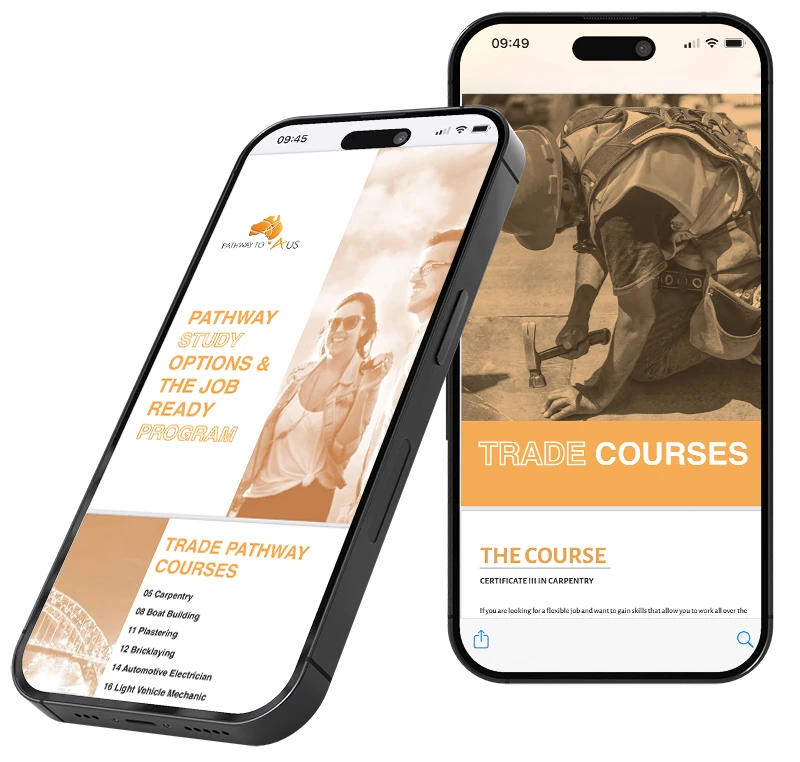Study Pathways to PR: 2025 Guide
Discover the exact trade courses and visa pathways that can lead you to permanent residency in Australia.
Get Your Free Guide
Enter your details to download the comprehensive PDF guide instantly.
What Pathway Guide covers?
Trade courses in Australia are vocational education and training (VET) programs that provide practical skills for specific industries. This guide is designed for international students seeking hands-on qualifications that can lead to meaningful career opportunities.
The pathway typically follows a clear progression: enroll in a recognised trade course, develop vocational skills through classroom and workplace learning, gain practical experience, and explore various post-study work options that may support long-term career goals in Australia.
 Available
Available
Nicholas Yock
Study Pathways to PR Specialist
10+ Years of Experience
What you’ll get?
Everything you need to understand trade courses and plan your pathway to Australia
Course Structure
Entry Requirements
Study Duration & Fees
Vocational Placement
Application Process
Post-Study Pathways

Study to PR FAQs
Get clear answers to the most common questions international students have about studying in Australia and turning it into a pathway to permanent residency.
Is the ebook really free?
Yes, the guide is 100% free to download.
You’ll receive it instantly via email along with extra tips and updates to help you plan your study and PR journey.
What is a study pathway to PR in Australia?
A study pathway to PR is when international students complete an eligible course in Australia that leads to a visa and eventually permanent residency.
Typically, students enroll in trade or in-demand courses, apply for a Temporary Graduate visa (485), gain skilled work experience, and then transition to permanent residency visas like the 189, 190, or 491.
Which courses lead to PR in Australia?
Trade courses such as carpentry, automotive, plumbing, cookery, aged care, and childcare often lead to PR because they are on the skilled occupation list.
Nursing, engineering, IT, and social work courses are also common study pathways. The exact list changes depending on Australia’s skill shortages.
How long does it take to get PR after studying in Australia?
It usually takes 3–5 years after starting study to get PR, depending on the course, visa pathway, and state requirements.
Most students study for 2 years, then apply for the 485 visa to gain 18–24 months of work experience before applying for permanent residency.
Is the study-to-PR pathway guaranteed?
No, there’s no guaranteed PR pathway, but choosing the right course and location improves your chances.
Outcomes depend on meeting eligibility, occupation demand, points score, and visa criteria. Many students who plan carefully succeed.
What visa do I apply for after studying in Australia?
Most graduates apply for the Temporary Graduate visa (485) after completing at least two years of study. From there, you can transition to skilled visas (189, 190, 491) or employer sponsorships depending on your occupation and work experience.
How much does the PR pathway cost in Australia?
Costs vary by trade or degree. Trade courses may cost $8,000–$15,000 per year, while visa application fees range from $1,600–$4,500.
Can international students get PR in Australia through trade courses?
Yes, many international students gain PR by studying trade courses on the skilled occupation list.
Carpentry, plumbing, electrical, automotive, and cookery are among the most popular trades because of Australia’s skills shortage.
What are the benefits of PR in Australia?
PR gives you the right to live, work, and study in Australia permanently, plus access to Medicare and a path to citizenship.
Permanent residents can also sponsor family members, travel in and out of Australia freely, and apply for government jobs.
Do regional courses improve my PR chances?
Yes, studying in a designated regional area often gives extra visa points and access to regional PR visas.
Regional visas like the 491 can provide a faster and more secure pathway to permanent residency compared to metro cities.
Success Stories
First-hand stories from people we’ve helped secure visas, overcome challenges, and start a new chapter in Australia.
